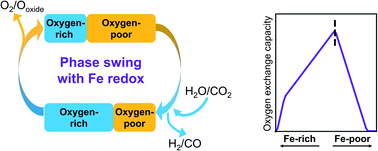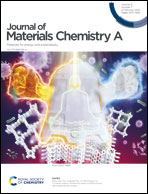Thermodynamic guiding principles of high-capacity phase transformation materials for splitting H2O and CO2 by thermochemical looping†
Abstract
Thermochemical looping splitting of water and carbon dioxide (CO2) with greenhouse-gas-free (GHG-free) energy has the potential to help address the Gt-scale GHG emissions challenge. Reaction thermodynamics largely contributes to the main bottlenecks of cost reduction for thermochemical looping water/CO2 splitting cycle. Here, we analyze thermodynamic driving forces in such cycles with two-phase ternary ferrites as model systems. We find that cation configurational entropy chiefly determines the change of partial molar entropy with oxygen stoichiometry. In addition, our phase diagram analysis accurately predicts the optimal Fe ratio for maximal water/CO2 splitting capacity in thermal reduction and in chemical reduction based cycles, underlining the significance of phase boundary positions. With chemical reduction, >10% CO2 conversion and high oxygen exchange capacity can both be achieved. Furthermore, our reduced Gibbs free energy model illustrates critical thermodynamic factors that influence the water/CO2 splitting capacity. Our research reveals the thermodynamic driving forces underlying the unconventional high-capacity Fe-poor ferrites, further explained via phase diagrams of Fe–Co–O, Fe–Ni–O and Fe–Mg–O. Future materials improvements can be guided by our reduced Gibbs free energy model.



 Please wait while we load your content...
Please wait while we load your content...